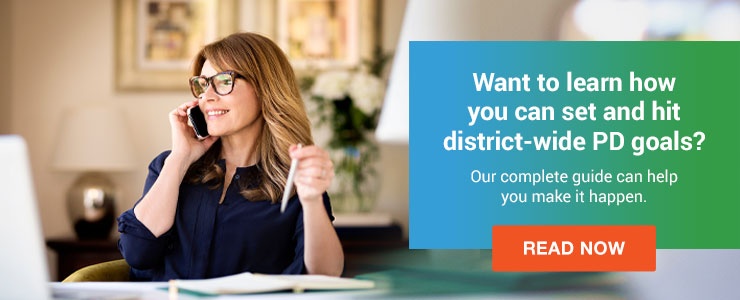Quick Tip Wednesday: How to Set Up a Gratitude Month
Welcome back to Quick Tip Wednesday!
6 min read
Julia Francis : Oct 19, 2021 4:00:00 PM

What is a master but a master student? And if that’s true, then there’s a responsibility on you to keep getting better and to explore avenues of your profession. ~ Neil Peart
Every great teacher is also an eager student. There’s no denying that effective teaching starts with effective learning. The best teachers are perpetually curious – and the same goes for effective administrators, and paraeducators. A school’s performance is only as good as its staff.
At Alludo, we specialize in identifying areas of professional growth for teachers and creating engaging, learner-centered modules for educators and administrators to use to add new skills and knowledge that will help them improve as teachers. Since teacher growth is tied to student outcomes, we thought we’d review some of the top areas of professional growth and training for teachers.
In any profession, there’s a risk of boredom and stagnation if there isn’t room for growth and professional development. Very few people would be satisfied doing the same job in the same way for years.
The profession of teaching changes all the time. Teaching techniques that were on the cutting edge twenty years ago are hopelessly outdated today. Professional learning for teachers is a must for many reasons.
/AL_01-Blog05-2.jpeg?width=450&name=AL_01-Blog05-2.jpeg)
In the classroom, there’s always space for more knowledge. When teachers are also students, they gain new information and learn new techniques all the time. That means that they’re able to take what they learn and pass it on to their students. Every new technique is an opportunity to connect with students in a new way.
Ongoing teacher training is the key to professional adaptability. No two students are alike and if teachers want to help their students get the best outcomes, they must be adaptable and agile in the classroom. The right professional learning model can help them to better understand the needs of their students and meet them where they are. The best teachers know that there’s no one-size-fits-all solution to connecting with students, and fostering teacher adaptability is one of the keys to student success.
Teacher retention is an issue for every school district. Research shows that the average school district loses 8% of teachers to other professions every year and another 8% to other school districts. Since hiring and onboarding new teachers can be expensive, it stands to reason that keeping teachers engaged and excited about their jobs is a good investment for school districts of all sizes. Administrators, staff, and teaching assistants and paraeducators can also benefit from ongoing training that allows them to grow in their jobs.
There’s a direct correlation between student outcomes and teacher professional development. When teachers are striving to improve their classroom performance, bringing new techniques and technologies into the mix, students are more likely to perform up to their potential. Since school districts are typically judged based on student outcomes, it’s important for teachers to be provided with the opportunity to improve their performance in the classroom and add professional skills to enhance their teaching.
While each school district must decide which growth goals they want to encourage, there are some areas of professional growth that are essential for teachers.
/AL_01-Blog05-3.jpeg?width=450&name=AL_01-Blog05-3.jpeg)
A teacher’s primary job is communication. In the classroom, teachers must communicate new concepts and theories to students in a way they can understand. They must also communicate with administrators, staff, and parents. The same is true of administrators and other staff members. Giving teachers the communication tools and skills they need is essential to any professional growth program.
When educators don’t make an effort to engage their students, students may check out. They’ll report that the things they’re learning are boring and uninteresting. By contrast, a teacher who works hard to find relevant and engaging resources to use in their classroom is likely to inspire a high level of engagement and interest from students at all levels.
Educators must be good leaders if they are to be effective. Whether an educator is guiding a class full of students through a lesson, working one-on-one with a student who’s struggling, or developing new curricula, they must have the core leadership skills and abilities to do so effectively and efficiently.
Learning standards are constantly changing, with the rise of distance learning as an undeniable example. Teachers have had to adapt to a new classroom environment that includes Zoom meetings and a host of new distractions. There’s also an ongoing need for teachers to be able to assess individual students and adapt to their learning styles to get the best results.

Many schools are moving – or have already moved – to standards-based grading and student evaluations. For teachers to do a good job of meeting expectations in this area, they need proper instruction and guidance in the form of professional learning.
Technology has always had a place in the classroom and new technology is only effective in teaching when educators have the training they need to master it and explain it to their students. Whether that means adopting an online grading and homework system, setting up Zoom classes, or teaching kids how to use a smartboard, teachers must engage in ongoing study and learning to be able to bring technology into the classroom.
Organizational abilities are essential in teaching and education. Organization helps with lesson planning. It’s also an essential component in student outcomes, since a disorganized classroom may not yield the best results for students. An organized teacher can easily pass on necessary information to a substitute and adapt to unexpected circumstances as needed.
The very best teachers are those who understand the power of innovation and creativity. With effective professional learning, teachers get the tools and information they need to take their teaching to a new level, engaging with students and keeping their classrooms fresh and exciting.
Teachers must be able to gauge students’ interest and performance in the moment, picking up on behavioral cues to identify when a lesson is clicking and when students are tuning out. Professional learning can help teachers learn to recognize these cues and to evaluate their strategies in real time, assessing student interest and engagement and making adjustments as needed.
To create a growth plan for teachers, teacher buy-in is essential. When teachers and other staff aren’t involved in the process of choosing their own growth goals and developing rubrics to measure their progress, they’re less likely to be excited or engaged in professional learning.
There are five steps to creating a teacher-centered (or if you prefer, learner-centered) model for professional development.
/AL_01-Blog05-4.jpeg?width=450&name=AL_01-Blog05-4.jpeg)
A school or school district may already have a set of standards for teachers and educational staff, but an effective growth plan for teachers must start with teacher input. Professional learners at every level should have a part in identifying areas for improvement. Not only will this lead to a comprehensive and unbiased look at what will serve students, it also gets teachers to buy in early. When they feel they have a voice, they’re more likely to be invested in professional learning and eager to do it.
Just as no two students are the same, no two teachers are the same. Each teacher should have individualized goals designed to help them learn and grow. One way to accomplish this is to have teachers film themselves in the classroom and review the recordings using a rubric to determine where they can improve. It can be difficult to know how you appear to students without seeing it from their perspective.
Effective professional learning for teachers must incorporate school and district educational standards. While teachers can and should work to identify individual goals, it’s essential to tie those goals to educational standards and requirements. This combination offers the best chance for teachers to learn new skills and improve student outcomes while also allowing the school district to do what it needs to do.
One of the most challenging aspects of professional development in the educational system is determining how to measure the progress of teachers, administrators, and staff as they continue along the path of professional learning.
Alludo offers a way to measure professional development with easy-to-read metrics that district and school leaders can use to confirm that teachers have met their professional development requirements.
The final step is to encourage collaboration and communication at every level on an ongoing basis. Giving teachers a voice in developing professional learning curricula is an important first step, but you’ll also need their feedback and input going forward.
For example, what do learners like about your curricula? What do they think could be improved? An open door policy will ensure that teachers, administrators, and staff at every level feel that their voices matter.
Alludo offers a customizable, branded professional learning experience for teachers, teaching assistants, paraeducators, special education teachers, administrators, and staff. We’ve carefully curated lessons that work, and with our help, you can select core activities from the Alludo Content Catalog full of thousands of learning activities, build on what’s there, or DIY and incorporate choice to allow educators to self-direct their learning.
Professional development for teachers is most effective when teachers have a voice and administrators choose a system that prioritizes learner engagement while adhering to district educational standards and providing an easy way to track and measure progress and performance.
Want to reach up to 100% PD in your district? See how Alludo can help make it happen with our free professional development platform trial, including:
.png)
Welcome back to Quick Tip Wednesday!

Mid-Year Reflection: Your Secret to a Stronger Second Semester
A great way to get your learners engaged in your Alludo program is by keeping the content in your program up-to-date and relevant. Rebecca has...